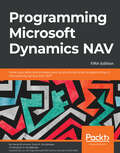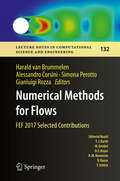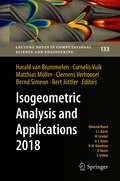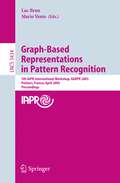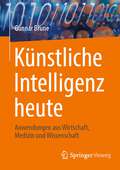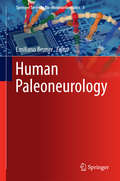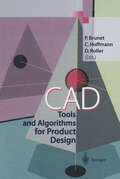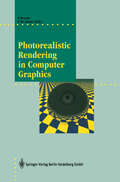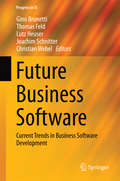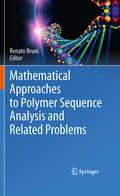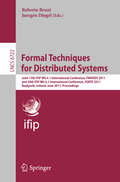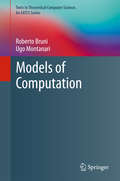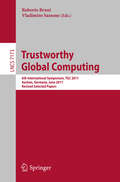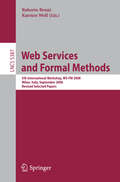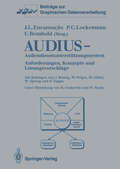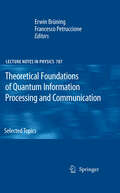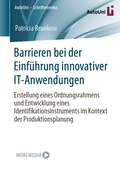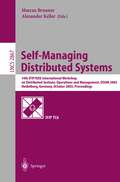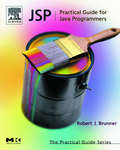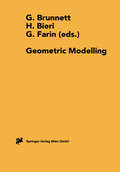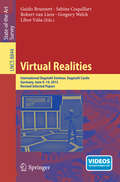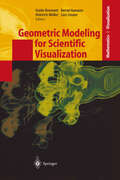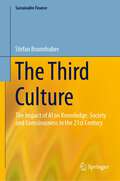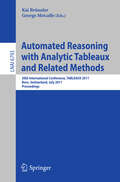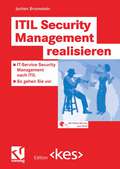- Table View
- List View
Programming Microsoft Dynamics NAV
by Mark BrummelMicrosoft Dynamics NAV is a full business solution suite, and a complete ERP solution, which contains a robust set of development tools to support customization and enhancement. These tools help in greater control over financials and can simplify supply chain, manufacturing, and operations. This book will take you from an introduction to Dynamics NAV and its integrated development tools to being a productive developer in the Dynamics NAV Development Environment.
Numerical Methods for Flows: FEF 2017 Selected Contributions (Lecture Notes in Computational Science and Engineering #132)
by Harald Van Brummelen Alessandro Corsini Simona Perotto Gianluigi RozzaThis book includes selected contributions on applied mathematics, numerical analysis, numerical simulation and scientific computing related to fluid mechanics problems, presented at the FEF-“Finite Element for Flows” conference, held in Rome in spring 2017. Written by leading international experts and covering state-of-the-art topics in numerical simulation for flows, it provides fascinating insights into and perspectives on current and future methodological and numerical developments in computational science. As such, the book is a valuable resource for researchers, as well as Masters and Ph.D students.
Isogeometric Analysis and Applications 2018 (Lecture Notes in Computational Science and Engineering #133)
by Harald Van Brummelen Cornelis Vuik Matthias Möller Clemens Verhoosel Bernd Simeon Bert JüttlerThis proceedings volume gathers a selection of outstanding research papers presented at the third Conference on Isogeometric Analysis and Applications, held in Delft, The Netherlands, in April 2018. This conference series, previously held in Linz, Austria, in 2012 and Annweiler am Trifels, Germany, in 2014, has created an international forum for interaction between scientists and practitioners working in this rapidly developing field. Isogeometric analysis is a groundbreaking computational approach that aims to bridge the gap between numerical analysis and computational geometry modeling by integrating the finite element method and related numerical simulation techniques into the computer-aided design workflow, and vice versa. The methodology has matured over the last decade both in terms of our theoretical understanding, its mathematical foundation and the robustness and efficiency of its practical implementations. This development has enabled scientists and practitioners to tackle challenging new applications at the frontiers of research in science and engineering and attracted early adopters for this his novel computer-aided design and engineering technology in industry. The IGAA 2018 conference brought together experts on isogeometric analysis theory and application, share their insights into challenging industrial applications and to discuss the latest developments as well as the directions of future research and development that are required to make isogeometric analysis an established mainstream technology.
Graph-Based Representations in Pattern Recognition: 5th IAPR International Workshop, GbRPR 2005, Poitiers, France, April 11-13, 2005, Proceedings (Lecture Notes in Computer Science #3434)
by Luc Brun Mario VentoMany vision problems have to deal with di?erent entities (regions, lines, line junctions, etc.) and their relationships. These entities together with their re- tionships may be encoded using graphs or hypergraphs. The structural inf- mation encoded by graphs allows computer vision algorithms to address both the features of the di?erent entities and the structural or topological relati- ships between them. Moreover, turning a computer vision problem into a graph problem allows one to access the full arsenal of graph algorithms developed in computer science. The Technical Committee (TC15, http://www.iapr.org/tcs.html) of the IAPR (International Association for Pattern Recognition) has been funded in order to federate and to encourage research work in these ?elds. Among its - tivities, TC15 encourages the organization of special graph sessions at many computer vision conferences and organizes the biennial workshop GbR. While being designed within a speci?c framework, the graph algorithms developed for computer vision and pattern recognition tasks often share constraints and goals with those developed in other research ?elds such as data mining, robotics and discrete geometry. The TC15 community is thus not closed in its research ?elds but on the contrary is open to interchanges with other groups/communities.
Künstliche Intelligenz heute: Anwendungen aus Wirtschaft, Medizin und Wissenschaft
by Gunnar BruneKünstliche Intelligenz wird schon heute in vielen Unternehmen angewendet. Und es werden immer mehr. Schon bald werden KI-Anwender starke Wettbewerbsvorteile erzielen, weil sie bessere Produkte anbieten, die haltbarer sind, effizienter produziert wurden und wahrscheinlich auch nachhaltiger sein werden. Diese Unternehmen haben also gleich mehrere Vorteile. Aber: Dies sind nur selten deutsche Unternehmen. Und es sind noch seltener deutsche Startups. In diesem Buch spricht Gunnar Brune mit Anwendern, Forschern und Investoren aus Wirtschaft, Medizin und Wissenschaft, um zu zeigen, wie Machine Learning und Künstliche Intelligenz erfolgreich und oft überraschend einfach zum Einsatz kommen (Applied AI). Die Lektüre bietet Informationen, Ansätze und Inspiration für den nutzbringenden Einsatz von Künstlicher Intelligenz heute.
Human Paleoneurology (Springer Series in Bio-/Neuroinformatics #3)
by Emiliano BrunerThe book presents an integrative review of paleoneurology, the study of endocranial morphology in fossil species. The main focus is on showing how computed methods can be used to support advances in evolutionary neuroanatomy, paleoanthropology and archaeology and how they have contributed to creating a completely new perspective in cognitive neuroscience. Moreover, thanks to its multidisciplinary approach, the book addresses students and researchers approaching human paleoneurology from different angles and for different purposes, such as biologists, physicians, anthropologists, archaeologists and computer scientists. The individual chapters, written by international experts, represent authoritative reviews of the most important topics in the field. All the concepts are presented in an easy-to-understand style, making them accessible to university students, newcomers and also to anyone interested in understanding how methods like biomedical imaging, digital anatomy and computed and multivariate morphometrics can be used for analyzing ontogenetic and phylogenetic changes according to the principles of functional morphology, morphological integration and modularity.
CAD Tools and Algorithms for Product Design
by Pere BrunetA look at important new tools and algorithms for future product modeling systems, based on a seminar at the International Conference and Research Center for Computer Science, Schloß Dagstuhl, Germany, presented by internationally recognised experts in CAD technology.
Photorealistic Rendering in Computer Graphics: Proceedings of the Second Eurographics Workshop on Rendering (Focus on Computer Graphics)
by Pere Brunet Frederik W. JansenPhotorealistic rendering strives to generate images from computer modeled scenes with an image quality as close to real life as possible. A major issue in rendering is simulation of local and global light reflection in a scene. Both ray tracing and radiosity algorithms capture only some of the possible light reflection phenomena. Recently developed two-pass algorithms combine the ray tracing and radiosity approaches and are able to capture the whole range of light reflection. This book is a collection of papers discussing the latest developments, including a new range of improvements, in stochastic sampling strategies, radiosity form factor calculation, and parallel processing for ray tracing and radiosity. A number of papers on rendering applications in interior design, lighting design, and remote sensing conclude the volume. The contributions are revised versions of papers originally presented at the Second Eurographics Workshop on Rendering, held in Barcelona, Spain, in May 1991. The book fully reflects the state of the art in rendering and presentsa wide variety of novel techniques. It will interest researchers and students in computer graphics, as well as designers who want to apply rendering techniques for realistic simulation in lighting design, interior design, and architecture.
Future Business Software: Current Trends in Business Software Development (Progress in IS)
by Gino Brunetti Thomas Feld Lutz Heuser Joachim Schnitter Christian WebelWhat will business software look like in the future? And how will it be developed?This book covers the proceedings of the first international conference on Future Business Software – a new think tank discussing the trends in enterprise software with speakers from Europe’s most successful software companies and the leading research institutions. The articles focus on two of the most prominent trends in the field: emergent software and agile development processes.“Emergent Software” is a new paradigm of software development that addresses the highly complex requirements of tomorrow’s business software and aims at dynamically and flexibly combining a business software solution’s different components in order to fulfill customers’ needs with a minimum of effort. Agile development processes are the response of software technology to the implementation of diverse and rapidly changing software requirements. A major focus is on the minimization of project risks, e.g. through short, iterative development cycles, test-driven development and an intensive culture of communication.
Mathematical Approaches to Polymer Sequence Analysis and Related Problems
by Renato BruniAn edited volume describing the latest developments in approaching the problem of polymer sequence analysis, with special emphasis on the most relevant biopolymers (peptides and DNA) but not limited to them. The chapters will include peptide sequence analysis, DNA sequence analysis, analysis of biopolymers and nonpolymers, sequence alignment problems, and more.
Formal Techniques for Distributed Systems: Joint 13th IFIP WG 6.1 International Conference, FMOODS 2011, and 30th IFIP WG 6.1 International Conference, FORTE 2011, Reykjavik, Island, June 6-9, 2011, Proceedings (Lecture Notes in Computer Science #6722)
by Roberto Bruni Juergen DingelThis book constitutes the refereed proceedings of the 13th IFIP WG 6.1 International Conference on Formal Methods for Open Object-Based Distributed Systems, FMOODS 2011, and the 31st IFIP WG 6.1 Formal Techniques for Networked and Distributed Systems, FORTE 2011, held in Reykjavik, Island, in June 2011, as one of the DisCoTec 2011 events. The 21 revised full papers presented together with one invited talk were carefully reviewed and selected from 65 submissions. The topics covered are formal verification, formal modeling and specification, run-time monitoring, and testing to address challenges in many different application areas, including dynamic and ad hoc networks, mobile and adaptive computation, reactive and timed systems, business processes, and distributed and concurrent systems and algorithms.
Models of Computation (Texts in Theoretical Computer Science. An EATCS Series)
by Roberto Bruni Ugo MontanariThis book presents in their basic form the most important models of computation, their basic programming paradigms, and their mathematical descriptions, both concrete and abstract. Each model is accompanied by relevant formal techniques for reasoning on it and for proving some properties. After preliminary chapters that introduce the notions of structure and meaning, semantic methods, inference rules, and logic programming, the authors arrange their chapters into parts on IMP, a simple imperative language; HOFL, a higher-order functional language; concurrent, nondeterministic and interactive models; and probabilistic/stochastic models.The authors have class-tested the book content over many years, and it will be valuable for graduate and advanced undergraduate students of theoretical computer science and distributed systems, and for researchers in this domain. Each chapter of the book concludes with a list of exercises addressing the key techniques introduced, solutions to selected exercises are offered at the end of the book.
Trustworthy Global Computing: 6th International Symposium, TGC 2011, Aachen, Germany, June 9-10, 2011. Revised Selected Papers (Lecture Notes in Computer Science #7173)
by Roberto Bruni Vladimiro SassoneThis book constitutes the refereed proceedings of the 6th International Symposium on Trustworthy Global Computing, TGC 2011, held in Aachen, Germany, in June 2011. The 14 revised full papers presented were carefully reviewed and selected from 25 submissions. The papers are organized in topical sections on modeling formalisms for concurrent systems; model checking and quantitative extensions thereof; semantics and analysis of modern programming languages; probabilistic models for concurrency; and testing and run-time verification.
Web Services and Formal Methods: 5th International Workshop, WS-FM 2008, Milan, Italy, September 4-5, 2008, Proceedings (Lecture Notes in Computer Science #5387)
by Roberto Bruni Karsten WolfThis book constitutes the thoroughly refereed post-workshop proceedings of the 5th International Workshop on Web Services and Formal Methods, WS-FM 2008, held in Milan, Italy, in September 2008 in conjunction with the 6th International Conference on Business Process Management, BPM 2008. The 13 revised full papers presented together with one invited paper were carefully reviewed and selected from 39 submissions. The papers feature topics such as analysis, test, and verification; choreographies and process calculi; transactions and interoperability; workflows and petri nets.
Audius—Außendienstunterstützungssystem: Anforderungen, Konzepte und Lösungsvorschläge (Beiträge zur Graphischen Datenverarbeitung)
by J. Brünig W. Felger M. Göbel M. Spreng P. Zuppa H. Grabowski W. StuckyDie Unternehmensführung ist heute auf umfassende, aber korrekte, vor allem strukturierte, vom Außendienstmitarbeiter unbeeinflußte Informationen über den Wirkungsgrad des Außendienstes und über das Marktgeschehen angewiesen. Das Forschungszentrum Informatik an der Universität Karlsruhe und die Fraunhofer-Arbeitsgruppe Graphische Datenverarbeitung, Darmstadt, bearbeiten deshalb ein gemeinsames Projekt AUDIUS zur Unterstützung des Außendienstes durch DV-Systeme. Das Buch enthält eine ausführliche Analyse der Aufgaben des Außendienstes, seiner Ziele und Probleme sowie der an ihn gestellten Anforderungen. Es gibt einen Überblick über den Stand der Technik bei den Komponenten, die im Rahmen eines integrativen DV-Ansatzes zur Unterstützung des Außendienstes Verwendung finden können. Ein erstes Grobkonzept einer modularen, flexibel konfigurierbaren Basisarchitektur und Strategien zur Einführung eines solchen Systems werden vorgestellt. Das Buch wendet sich an Fachleute aus der Praxis, die Anbieter oder Anwender derartiger Systeme werden wollen, sowie an Wirtschaftswissenschaftler und Ingenieure mit Interesse an Arbeitsorganisation.
Theoretical Foundations of Quantum Information Processing and Communication: Selected Topics (Lecture Notes in Physics #787)
by Erwin Brüning Francesco PetruccioneBased on eight extensive lectures selected from those given at the renowned Chris Engelbrecht Summer School in Theoretical Physics in South Africa, this text on the theoretical foundations of quantum information processing and communication covers an array of topics, including quantum probabilities, open systems, and non-Markovian dynamics and decoherence. It also addresses quantum information and relativity as well as testing quantum mechanics in high energy physics. Because these self-contained lectures discuss topics not typically covered in advanced undergraduate courses, they are ideal for post-graduate students entering this field of research. Some of the lectures are written at a more introductory level while others are presented as tutorials that survey recent developments and results in various subfields.
Barrieren bei der Einführung innovativer IT-Anwendungen: Erstellung eines Ordnungsrahmens und Entwicklung eines Identifikationsinstruments im Kontext der Produktionsplanung (AutoUni – Schriftenreihe #172)
by Patricia BrunkowPatricia Brunkow gibt einen Überblick über relevante Barrieren bei der Einführung von IT-Anwendungen in Unternehmen und stellt zwei Instrumente zur Identifikation und Vermeidung von Barrieren vor. Die Ergebnisse dieser Arbeit bieten aufgrund der Datenerhebung in einem Automobilunternehmen besonders praxisnahe Erkenntnisse.
Self-Managing Distributed Systems: 14th IFIP/IEEE International Workshop on Distributed Systems: Operations and Management, DSOM 2003, Heidelberg, Germany, October 20-22, 2003, Proceedings (Lecture Notes in Computer Science #2867)
by Marcus Brunner Alexander KellerThis book constitutes the refereed proceedings of the 14th IFIP/IEEE International Workshop on Distributed Systems: Operations and Management, DSOM 2003, held in Heidelberg, Germany in October 2002. The 20 revised full papers and 6 revised short papers presented together with a keynote paper were carefully reviewed and selected from a total of 105 submissions. The papers are organized in topical sections on self-configuration, peer-to-peer management, self-optimization and performance management, utility management, self-protection and access control, manageability and instrumentation, and context-awareness.
JSP: Practical Guide for Programmers (The Practical Guides)
by Robert BrunnerJavaServer Pages (JSP) is a technology for building dynamic web applications that can access databases and provide an interactive experience for users. It's a powerful technology with open source implementations (server and platform independent) for building enterprise Web applications. With JSP, existing business systems can be leveraged with minimal overhead, maintenance, and support. JSP: Practical Guide for Java Programmers is designed to cover the essentials of JSP including the basic JSP constructs and the relevant implicit objects as well as more advanced concepts such as incorporating JavaBeans, developing custom tags, utilizing the JSP expression language, building with the JSP Standard Tag Library, and developing complete JSP-Servlet application.Covers the latest release of JSP, version 2.0, and covers new features such as the Expression Language and Standard Tag Library.Includes a sample application of an electronic bank Web site, showing the power of JSP in providing the foundation for building Web applications.Provides a clear, straight-to-the-point approach to the JSP so that readers can start using it in their own projects right away.
Geometric Modelling: Dagstuhl 1999 Computing Supplement 14 (Computing Supplementa #14)
by G. Brunnett H. Bieri G. FarinGeometric Modelling is concerned with the computer aided design, manipulation, storage and transmission of geometric shape. It provides fundamental techniques to different areas of application as CAD/CAM, computer graphics, scientific visualization, and virtual Reality. 20 papers presented by leading experts give a state-of-the-art survey of the following topics: surface design and fairing; multiresolution models; reverse engineering; solid modelling; constrained based modelling.
Virtual Realities: International Dagstuhl Seminar, Dagstuhl Castle, Germany, June 9-14, 2013, Revised Selected Papers (Lecture Notes in Computer Science #8844)
by Guido Brunnett Sabine Coquillart Robert Van Liere Gregory Welch Libor VášaVirtual reality (VR) is a multidisciplinary area of research aimed at interactive human–computer-mediated simulations of artificial environments. An important aspect of VR-based systems is the stimulation of the human senses – usually sight, sound, and touch – in such a way that a user feels a sense of presence in the virtual environment. Sometimes it is important to combine real and virtual objects in the same real or virtual environment. This approach is often referred to as augmented reality (AR), when virtual objects are integrated into a real environment. Typical VR applications include simulation, training, scientific visualization, and entertainment, whereas typical AR applications include computer-aided manufacturing or maintenance and computer-aided surgery or medicine.This book comprises a collection of research and position papers presented at Dagstuhl Seminar 13241 on Virtual Realities, held at Schloss Dagstuhl, Germany, in June 2013. The 13 papers in this volume were carefully reviewed and selected from 18 submissions. They are organized in topical sections on: VR environments; interactions and user experience; virtual humans; and tele-existence.
Geometric Modeling for Scientific Visualization (Mathematics and Visualization)
by Guido Brunnett Bernd Hamann Heinrich Müller Lars LinsenGeometric Modeling and Scientific Visualization are both established disciplines, each with their own series of workshops, conferences and journals. But clearly both disciplines overlap; this observation led to the idea of composing a book on Geometric Modeling for Scientific Visualization.
The Third Culture: The Impact of AI on Knowledge, Society and Consciousness in the 21st Century (Sustainable Finance)
by Stefan BrunnhuberWe are currently witnessing the emergence of a ‘third culture’, driven by unprecedented developments that are changing the playing field. These include advances in AI, big data analysis and robotics. The traditional ‘two cultures’ view (S. P. Snow) distinguishes between the sciences and the humanities. The wisdoms these two cultures offer are separated from each other, with little to no interaction or mutual comprehension. However, over the past two decades, and for the first time in human history, a new, third culture has appeared. This new culture, rooted in new technologies, not only pursues its own form of rationality but also supports advances in the original two cultures, deepening and expanding our individual and collective consciousness so that we can see more and do better. It will eventually give rise to new forms of consciousness based not on biochemical signals, but on copper wires and lithium chips. These new machine intelligences will change the world and force us to realise: we are no longer alone. The human species’ position in the twenty-first century will be fundamentally redefined: not as a conductor leading the orchestra, but a single string player within it.
Automated Reasoning with Analytic Tableaux and Related Methods: 20th International Conference, TABLEAUX 2011, Bern, Switzerland, July 4-8, 2011, Proceedings (Lecture Notes in Computer Science #6793)
by Kai Brünnler George MetcalfeThis book constitutes the refereed proceedings of the 20th International Conference on Automated Reasoning with Analytic Tableaux and Related Methods, TABLEAUX 2011, held in Bern, Switzerland, in July 2011.The 16 revised research papers presented together with 2 system descriptions were carefully reviewed and selected from 34 submissions. The papers cover many topics in the wide range of applications of tableaux and related methods such as analytic tableaux for various logics, related techniques and concepts, related methods, new calculi and methods for theorem proving in classical and non-classical logics, as well as systems, tools, implementations and applications; all with a special focus on hardware and software verifications, semantic technologies, and knowledge engineering.
ITIL Security Management realisieren: IT-Service Security Management nach ITIL - So gehen Sie vor (Edition <kes>)
by Jochen BrunnsteinWie kaum eine andere Technik zuvor haben sich Informatio- und Kommunikationstechniken verschiedenster Art nahezu e- losionsartig in Unternehmen und Organisationen ausgebreitet. Diese Entwicklung, angeblich vom Markt getrieben, ist zwar von den Vorständen vieler Unternehmen wegen ihrer innovativen und rationalisierenden Wirkungen oft gewollt, aber mangels V- stehens der diesen zugrunde liegenden Prozessen meist unzur- chend gesteuert worden. Ebenfalls mangels systematischer P- nung und Überwachung bei der Einführung von IT-Verfahren hat sich vielerorts ein Wildwuchs an DV- und IT-Systemen e- wickelt, welche neben unzureichender Kompatibilität vor allem erhebliche Schwachpunkte – etwa geringem Widerstand gegen Angriffe von außen und innen sowie vor allem häufige Ausfälle oder Fehlfunktionen wichtiger Teilsysteme – zu schwer ver- cherbaren Risiken werden lassen. Dabei erweisen sich besonders die Internet-gestützten Verbindungen innerhalb der Untern- men sowie zu Lieferanten, Kunden und dritten Partnern (etwa der Steuerverwaltung) als besondere Angriffspunkte, welche - nehmend – ob mit lustvollem Hacking oder krimineller Energie – die Existenz und Profitabilität von Unternehmen gefährden. Gegen diese Entwicklung versuchen interessierte Kreise seit l- gem, vermeintlich „sichere Software und Systeme“ zu entwickeln und am Markt durchzusetzen. Lange Zeit hielt man es für zweckmäßig und ausreichend, für derartige Systeme einen „- cherheitsgrad“ zu definieren, wobei man Kriterienkataloge zugrunde legte.
